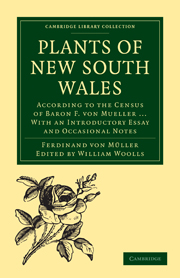 Plants of New South Wales
Plants of New South Wales PLANTS OE NEW SOUTH WALES
Published online by Cambridge University Press: 05 July 2011
Summary
DICOTYLEDONEÆ.
CHORIPETALEÆ HYPOGYNÆ.
The first family of dicotyledonous plants in the Census (the Choripetaleæ hypogynæ, or such plants as have disunited petals, or no petals, stamens inserted on the bottom of the calyx and at the base of the ovary, and the fruit free from the calyx) is that of the (1) Ranunculaceæ: or Crowfoots, of which the common Buttercup may be regarded as typical. This order contains five genera, including seventeen species, of which the following occur in New South Wales, viz.:—Of the genus Clematis, C. aristata, C. glycinoides, C. microphylla, and C. Fawcettii; of Myosurus, M. minimus; of Ranunculus, R. Millani, R. anemoneus, R. Gunnianus, R. lappaceus, R. Muelleri, R. rivularis, R. hirtus, R. parviflorus, and R. aquatilis; and of Caltha, C. introloba. Clematis, or, as popularly termed, “The Virgin's Bower,” is a genus of climbing plants, with pinnately or ternately divided leaves, and a profusion of white flowers. The most common form on this side of the Dividing Eange is C. aristata, whilst C. microphylla is that of the interior. C. Fawcettii is a species on the Richmond River. Myosurus minimus, or “Mousetail,” is a small plant only a few inches in height, and common not only to Victoria and Queensland, but also to Europe, Asia, and America. The flowers are very small and arranged in spikes on leafless stems.
- Type
- Chapter
- Information
- Plants of New South WalesAccording to the Census of Baron F. von Mueller ... With an Introductory Essay and Occasional Notes, pp. 15 - 110Publisher: Cambridge University PressPrint publication year: 2010First published in: 1885
